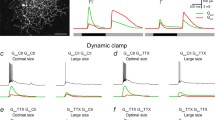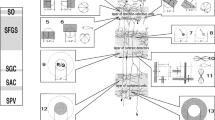Abstract
In the frog’s retina, the receptive fields of the ganglion cells are made of a central area (the excitatory receptive field or ERF) and of a peripheral area (the inhibitory receptive field or IRF). These two areas are antagonist: See Grusser & Grusser-Cornehls (1973). In order to explain this functional situation, it is necessary to ascribe great importance to the transverse cells of the retina: that is, the horizontal cells and the amacrine cells. In order to study this situation we have used the trans-retinal currents. These currents, or polarizing currents, are well known to alter the function of the retina. For instance, there are the subjective phosphenes (see Brindley, 1970). How does a polarizing current work? This is one problem we have encountered in this study.
Access this chapter
Tax calculation will be finalised at checkout
Purchases are for personal use only
Preview
Unable to display preview. Download preview PDF.
Similar content being viewed by others
References
Barlow, H.B. Summation and inhibition in the frog’s retina. J. Physiol. (London), 119, 69–88 (1953).
Brindley, G.S. Physiology of the retina and visual pathway. Edward Arnold, London (1970).
Grüsser, O.J. & Grüsser-Cornehls, U. Neuronal mechanisms of visual movement perception and some psychophysical and behavioral correlations. In: Handbook of sensory physiology, VII/3: Central processing of visual information-A: Integrative functions and comparative data. Ed. by Jung, R. pp 333/429. Springer Verlag, Berlin (1973).
Hartline, H.K. The response of single optic nerve fibres of the vertebrate eye to illumination of the retina. Amer. J. Physiol., 121, 400–415 (1938).
Liege, B. & Galand, G. Single-unit visual responses in the frog’s brain. Vision Res., 12, 609–622(1972).
Maturana H.R. Lettvin J.Y. McCulloch W.S. & Pitts W.H. Anatomy and physiology of vision in the frog (Rana pipiens). J. Gen. Physiol. 43 Suppl. 129–176 (1960)
Maximov, V., Liege, B. & Galand, G. Influence de la polarisation rétinienne sur la réponse retardée des cellules ganglionnaires de la grenouille. J. Physiol., (Paris), 67, 207A (1973).
Morin, G., Gaillard, G., Liege, B. & Galand, G. Réponses proprioceptives unitaires ä l’abaissement de la mächoirce enregistrées dans le tronc cérébral de la grenouille. Interactions hétérosensorielles visuelles. J. Physiol., (Paris) 68, 121–144 (1974).
Pickering, S.G. & Varju, D. Ganglion cells in the frog retina: inhibitory receptive field and long-latency response. Nature, 215, 545–546 (1967).
Tomita, T. Light-induced potential and resistance changes in vertebrate photo-receptors. In: Handbook of sensory physiology, Vol. VII/2: Physiology of photoreceptor organs. Ed. by Fuortes, M.G.F. pp 483/511. Springer-Verlag, Berlin (1972).
Toyoda, J.I., Hashimoto, H. & Ohtsu, K. Bipolar-amacrine transmission in the carp retina. Vision Res., 13, 295–307 (1973).
Varju, D. & Pickering, S.G. Delayed responses of ganglion cells in the frog retina: the influence of stimulus parameters upon their discharge pattern. Kybernetik, 6, 112–119 (1969).
Werblin, F.S. & Dowling, J.E. Organization of retina of the mudpuppy, Necturus maculosus-II: Intracellular recording. J. Neurophysiol., 32, 339–355 (1969).
Witkovski, P. Peripheral mechanisms of vision. Ann. Rev. Physiol., 33, 257–280 (1971).
Author information
Authors and Affiliations
Editor information
Rights and permissions
Copyright information
© 1976 Dr W. Junk b.v. Publishers
About this chapter
Cite this chapter
Maximov, V., Liege, B., Galand, G. (1976). Behaviour of the Ganglion Cells of the Frog’s Retina Submitted to a Polarizing Current: An in Vivo Study. In: Alfieri, R., Solé, P. (eds) XIIth I. S. C. E. R. G. Symposium. Documenta Ophthalmologica Proceedings Series, vol 10. Springer, Dordrecht. https://doi.org/10.1007/978-94-010-1575-2_17
Download citation
DOI: https://doi.org/10.1007/978-94-010-1575-2_17
Publisher Name: Springer, Dordrecht
Print ISBN: 978-90-6193-150-8
Online ISBN: 978-94-010-1575-2
eBook Packages: Springer Book Archive




